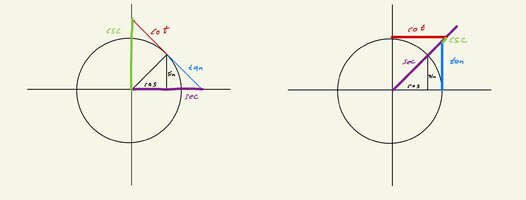You are using an out of date browser. It may not display this or other websites correctly.
You should upgrade or use an alternative browser.
You should upgrade or use an alternative browser.
Two Different Illustrations of Trig Ratios Tangent, Cotangent, Secant, Cosecant in terms of Unit Circle
- Thread starter jpanknin
- Start date
Dr.Peterson
Elite Member
- Joined
- Nov 12, 2017
- Messages
- 16,863
The second is more like what I've used, but the way you drew it, it doesn't represent the secant and cosecant very well. (Your colored lines are in the wrong places, and the overlapping of the two segments is awkward.)I keep seeing two different ways to represent the tangent, cotangent, secant, and cosecant in terms of the unit circle (image attached). Is there any benefit to using one vs. the other? Or any reason for having two different representations?
I myself don't generally try to fit all six functions into the same picture, but just show what sin, tan, and sec mean geometrically (as in the second picture), and then the cofunctions are just the same things applied to the complement. (The fact that the cosine easily fits into the same picture does make it tempting to include them all, though.) I also don't think knowing the etymology of the functions helps much in learning them, and likewise the pictures seem less useful than the definitions themselves.
But the existence of these two representations (and others) is about as significant as the fact that one can describe the same concept in different words (that is, not at all). I'm not sure that any of these was drawn when the terms were first devised; but then, historical precedence wouldn't make that drawing necessarily better anyway.
Yeah, it gets a little messy with the secant and cosecant overlapping. I was just wondering if one approach was more conducive to one type of problem and vice versa, but you answered that @Dr.Peterson. Thanks for the help.

